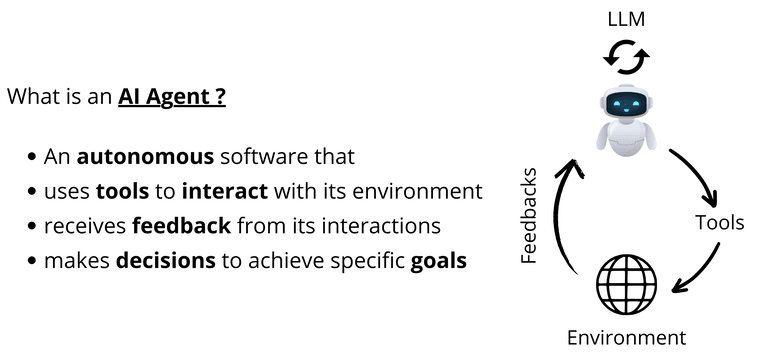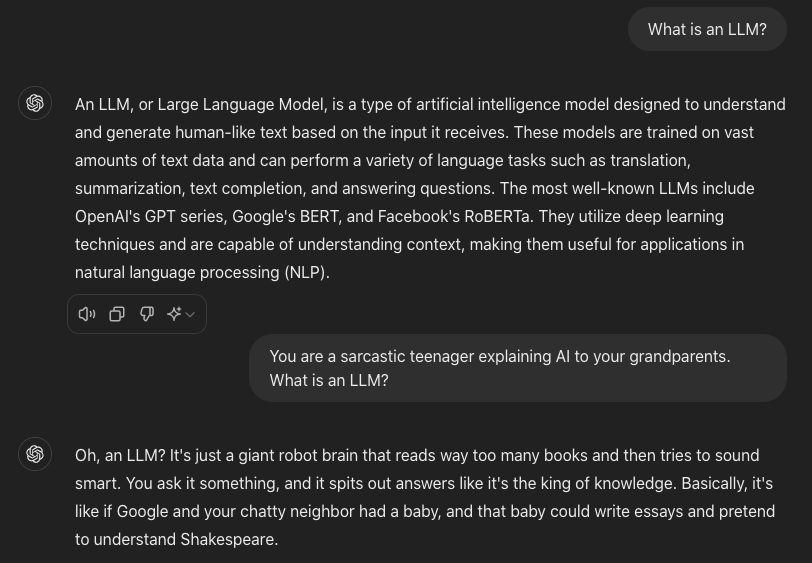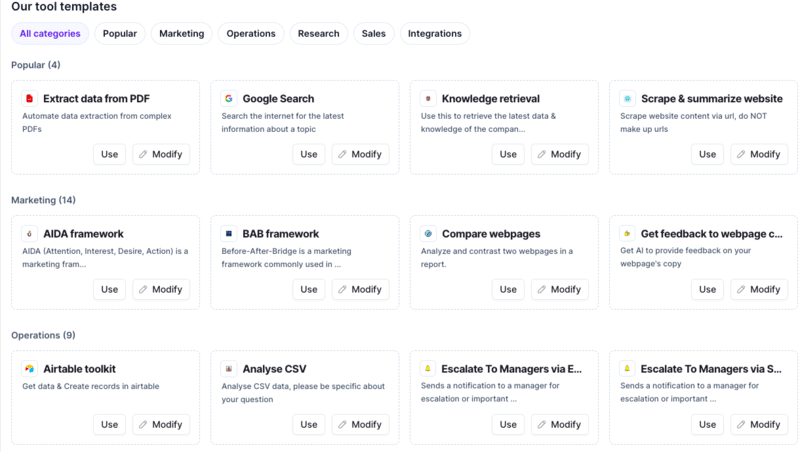All You Need to Know About AI Agents: A Full Guide
 Aymen K
Aymen K
Generative AI agents are a hot topic, with many claiming they'll revolutionize the world. But what exactly are they?
In this post, we'll demystify generative AI agents and explore real-world examples of their application. By the end, you'll understand:
What a generative AI agent is
How AI agents differ from AI automation
Keys to design effective AI agents
Equipping AI agents with tools
What is a Generative AI Agent?
Generative AI agents combine two key components:
Generative AI (Large Language Models or LLMs e.g. chatGPT, LLAMA3).
Traditional AI Agents (AI-driven decision-making).

Generative AI agents use large language models (LLMs) like GPT-4 or Llama3 as their "brain" to decide which actions to take or tools to use to achieve a specific goal.
AI agents are often confused with AI automation, but they're distinct concepts.

To differentiate between them, ask yourself:
Yes → AI agent
No → AI automation
Can the AI system learn from its interactions with the environment to make better decisions?
Let's compare a standard chatbot with an AI sales agent:
Standard Website Chatbot:
Responds to predefined questions
Provides scripted answers
Can't adapt beyond its programming
AI Sales Agent:
Accesses detailed product information
Uses a recommendation tool based on customer preferences
Handles payment processing
Manages meeting schedules
For example if a customer interacts with the AI sales agent looking for a new laptop. The agent can:
Asks about the customer's needs (e.g., for gaming, work, or casual use)
Uses its product database to find matching laptops
Recommends laptops based on the customer's budget and requirements
Answers questions about specs and features
Processes the payment when the customer decides to buy
Schedules a follow-up for setup assistance
Throughout this interaction, the AI agent adapts its responses based on the customer's feedback, making it more effective than a standard chatbot.
Now that we understand what are AI agents, let's see how we can build them.
How to Design Effective AI Agents
Designing effective AI agents involves several key considerations:
Identity
Narrow scope
Memory
Planning
Access to external tools
We’ll dive into each below.
1. Identity:
The role or persona you assign to an AI agent significantly influences the quality of its responses.
Consider these two prompts and their answers:
What is an LLM?
You are a sarcastic teenager explaining AI to your grandparents. What is an LLM?

In the second prompt, the brief identity assignment led ChatGPT to adopt the persona of a sarcastic teenager explaining AI to their grandparents, transforming its response in several ways:
Content: The information presented was more casual and humorous.
Writing Style: The tone became more conversational and relatable.
Humor: The response included sarcasm to entertain and engage.
Comprehension Level: The explanation was simplified and analogies were used.
Technical Detail: The answer was less formal and more accessible.
Understanding and carefully crafting the identity and context for each AI agent is essential.
Regularly experiment to determine the most effective identity for your specific requirements.
For instance, an AI agent designed as a customer service representative should be friendly and empathetic, while a technical support agent should channel their inner tech wizard, complete with geeky charm.
You wouldn’t want your tech support agent cracking jokes about why the computer crossed the road, would you?
2. Narrow Scope:
Research consistently shows that LLMs excel when given clear, specific tasks rather than broad, open-ended ones.
Overloading an agent with excessive information or context can reduce accuracy and increase the risk of generating false responses or hallucinations.
The secret is to maintain a sharply focused scope for each agent.
Give each agent a single, well-defined objective. Avoid creating a “jack of all trades” agent. Instead, aim for a master of one.
Rather than depending on one agent to tackle multiple complex tasks, build a team of specialized agents, each with a distinct area of expertise.
For example, in an AI-driven customer service system, you could organize your team as follows:
One agent handles initial query classification
Another agent retrieves relevant information from your knowledge base
A third agent crafts personalized responses based on the information gathered
This focused approach not only boosts performance of the agents but also increases output quality and decreases hallucinations.
3. Memory:
Memory is key to making AI agents effective in the real world.
Just like human memory, AI memory lets agents remember past actions and results, think about their performance, and use these insights to make better choices in the future.
Memory helps agents get better over time and adapt to new situations.
Short-term memory acts like a blank slate, starting fresh with each new task.
Long-term memory, stored usually in databases, keeps track of past experiences. After finishing a task, the agent reflects on its work and saves useful information for future use.
When faced with a new challenge, agents can use this stored knowledge to make smarter and more effective decisions.

4. Planning:
Not every task can be broken down into simple steps from the beginning. Some goals need a more flexible approach to handle unexpected issues and adapt to changing circumstances.
With strategic planning, agents can handle complex tasks by figuring out the necessary steps as they go.
For example, a travel booking agent planning a multi-city trip won't give up if a flight is full. The agent will look for other flights, consider different routes or airlines, and even check options like changing travel dates or nearby airports to meet the client's needs.
By letting agents assess their goals, review available options, and plan their actions, you improve their ability to manage complex situations and provide effective solutions.
In practice, adding the simple "Think step by step" statement to the agent will hugely improve its response.
5. Tools
LLMs are limited to the data they were trained on, which can restrict their ability to provide real time information, as many of us have seen with ChatGPT.
To address this, agents can be equipped with tools that allow them to interact with the external world.
These tools might include APIs, databases, and other services that help them search the internet, collect data, or perform specific actions.
Just as with defining an agent’s scope, it’s important not to overwhelm your agents with too many tools.
Provide each agent with only the essential tools needed to achieve its goal. Too many tools can be confusing, making it hard for the agent to know which one to use and leading to errors or mixed-up information.
In the next section, we’ll explore how to integrate these tools with your agents in more detail.
In summary, when creating an agent, consider the following:
Identity: The role you assign to an AI agent affects its response quality, so tailor the persona to match the task.
Narrow Scope: Focus each agent on a single task to improve accuracy and reduce errors, avoiding a “jack of all trades” approach.
Memory: Use memory to help agents remember past actions and learn from them, enhancing their future performance.
Planning: Allow agents to dynamically plan and adapt their approach to complex tasks, improving their flexibility and effectiveness.
Tools: Equip agents with essential tools for their tasks, but avoid overwhelming them with too many options to prevent confusion and errors.
How to Equip AI Agents with Tools
AI agents can use tools by leveraging a concept called function calling.
Function calling means giving an LLM access to external functions to interact with the real world.
It works like this:
The user asks the LLM, "What's the current weather in Barcelona?"
The LLM decides it needs weather data, so it calls a weather data tool.
The weather data tool fetches and returns the current weather information for Barcelona.
The LLM uses this weather information to provide an accurate response to the user.
As the name suggests, tools are normal programming functions being called by the LLM. They can be created in several ways:
Coding them from scratch, for example, using a programming language like Python.
Using builtin tools from established frameworks like Langchain or Llama Index. Below are some of the tools available in Langchain.
| Alpha Vantage | Google Finance | OpenWeatherMap |
| ArXiv | Google Jobs | Passio NutritionAI |
| AWS Lambda | Google Places | PubMed |
| Azure Container Apps dynamic sessions | Google Scholar | Python REPL |
| Shell (bash) | Google Search | Reddit Search |
| Bearly Code Interpreter | Google Serper | Requests |
| Bing Search | Google Trends | Tavily Search |
| Dall-E Image Generator | HuggingFace Hub Tools | SearchApi |
| DataForSEO | SerpAPI | Semantic Scholar API Tool |
| DuckDuckGo Search | Ionic Shopping Tool | SQL Database |
| Eleven Labs Text2Speech | Exa Search | Twilio |
| File System | NVIDIA Riva: ASR and TTS | Wikipedia |
| Google Cloud Text-to-Speech | Oracle AI Vector Search: Generate Summary | Wolfram Alpha |
| Google Drive | Passio NutritionAI | Yahoo Finance News |
| Google Finance | Polygon Stock Market API Tools | You.com Search |
| Google Imagen | PubMed | YouTube |
- Using a no-code platform like Relevance AI, which comes with various built-in tools and simplified templates to develop custom ones.

When designing an AI agent, you must provide it with all the necessary tools to achieve its tasks.
For example, an AI agent tasked with sales prospecting should be equipped with:
Research tools: to enrich lead information by accessing LinkedIn or social media profiles.
Scraping tools: to collect additional details from the lead's company websites.
Emailing tools: to send a personalized email to the lead.
CRM tools: to record the lead in the database for future follow-up.
An important thing to keep in mind while building these tools is error handling.
When an agent calls a tool, it expects to get a correct response. But what if the tool throws an error or exception?
Should the agent stop?
Should the agent try again?
You don't want your entire app to crash because of that! So you need to consider the following:
Your tools must have robust error handling.
They must provide helpful error messages to your agent (who may decide on a new plan).
Enable your agent to perform multiple tries if the first call fails.
In summary, tools are crucial for your AI agent:
They allow him to interact with the real world and perform tasks effectively.
They must be well-designed and robust to ensure your agent can handle errors gracefully.
They should be tailored to the agent's specific tasks to maximize efficiency and effectiveness.
What's Next?
In this article, we explored what AI agents are and how to design them effectively. You also discovered the key differences between AI agents and AI automation and learned how to equip your AI agents with the right tools to boost their performance.
🚀 Ready to take your AI skills to the next level?
Check out my GitHub for hands-on projects, builds, and experiments in AI automation and agent development!
Subscribe to my newsletter
Read articles from Aymen K directly inside your inbox. Subscribe to the newsletter, and don't miss out.
Written by

Aymen K
Aymen K
AI developer driven by a passion for creating intelligent solutions through AI automation and AI agents. Fascinated by the potential of AI to transform industries and solve complex problems. Constantly exploring new technologies and frameworks to build smarter, more efficient systems that push the boundaries of what AI can achieve.